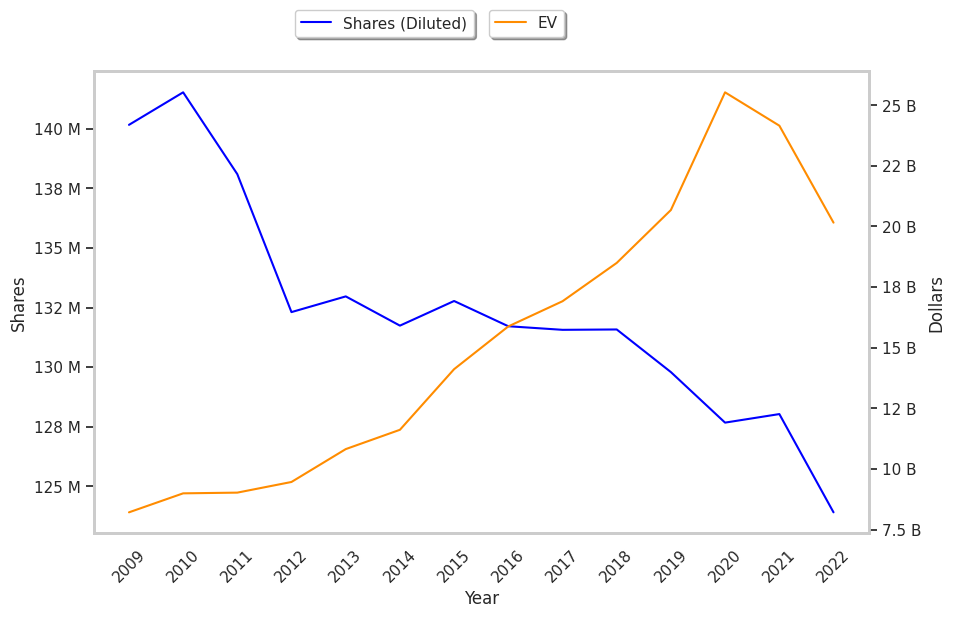Clorox Company (CLX) stock climbed 0.1 % this morning. According to our metrics, the company seems overvalued at today's prices. In the below analysis, we will put Clorox Company's valuation in the context of its poor growth indicators and mixed market sentiment, which are also strong drivers for share price.
The Clorox Company manufactures and markets consumer and professional products worldwide. The large-cap Consumer Discretionary company is based in Oakland, United States and has 8,700 full time employees.
CLX Has a Higher P/E Ratio Than the Sector Average
Compared to the Consumer Discretionary sector's average of 22.33, Clorox Company has a trailing twelve month price to earnings (P/E) ratio of 109.7 and an expected P/E ratio of 19.9. The P/E ratios are calculated by dividing the company's share price by its trailing 12 month of $1.14 or forward earnings per share of $6.29.
Earnings represent the net profits left over after subtracting costs of goods sold, taxes, and operating costs from the company's recorded sales revenue. One way of looking at the P/E ratio is that it represents how much investors are willing to pay for every dollar's worth of the company's earnings. Since Clorox Company's P/E ratio is higher than its sector average of 22.33, we can deduce that the market is overvaluing the company's earnings.
Clorox Company Is Overvalued in Terms of Expected Growth
Clorox Company's PEG ratio is 4.19. This metric represents the company's earnings per share divided by its expected growth ratio, and is a useful complement to the price to earnings analysis, because it factors in growth to the valuation. A PEG ratio around or below 1 implies that the market in fairly valuing the company in terms of its growth estimates. But when the PEG ratio is higher, as in Clorox Company's case, it tells us the company is overvalued.
CLX Has an Alarming P/B Ratio
The price to book (P/B) ratio of a company is a comparison of the company's market capitalization versus its net asset, or book value. A ratio lower than 1 tells you that the equity market is undervaluing the book value of the company's assets, and ratios higher than 1 tell you that the equity markets are overvaluing the company in terms of its assets.
Of course, a company is worth much more than its assets alone, so the focus on P/B ratio is mainly to enable investors to single out undervalued securities that offer a margin of safety. Since Clorox Company's P/B ratio of 70.38 is higher than its sector average of 3.12, such a margin of safety does not exist for the stock.
CLX's Weak Cash Flow Generation Is Troubling
The table below shows that Clorox Company is not generating enough cash. A well run company will generally have cash flows that reflect the strength of its underlying business, and in Clorox Company's case, free cash flow is growing at an average rate of 0.0% with a coefficient of variability of 14394939734.4%. We can also see that cash flows from operations are evolving at a 0.0% rate, versus 0.0%:
| Date Reported | Cash Flow from Operations ($ k) | Capital expenditures ($ k) | Free Cash Flow ($ k) | YoY Growth (%) |
|---|---|---|---|---|
| 2022-08-10 | 786,000 | -251,000 | 1,037,000 | -35.47 |
| 2021-08-10 | 1,276,000 | -331,000 | 1,607,000 | -10.72 |
| 2020-08-13 | 1,546,000 | -254,000 | 1,800,000 | 50.25 |
| 2019-08-14 | 992,000 | -206,000 | 1,198,000 | 2.57 |
| 2018-08-14 | 974,000 | -194,000 | 1,168,000 | 6.28 |
| 2017-08-15 | 868,000 | -231,000 | 1,099,000 |
Clorox Company's Margins Are Strong
If you buy a stock for the long run, you want the underlying business model to be profitable. Gross margins tell you how much profit the company generates compared to the cost of revenue, which is the cost directly related to providing Clorox Company's goods and services. Operating margins, on the other hand, tell you how much of these profits the company keeps after you take overhead into account.
Clorox Company's Gross Margins
| Date Reported | Revenue ($ k) | Cost of Revenue ($ k) | Gross Margins (%) | YoY Growth (%) |
|---|---|---|---|---|
| 2022-08-10 | 7,107,000 | -4,562,000 | 36 | -18.18 |
| 2021-08-10 | 7,341,000 | -4,142,000 | 44 | -4.35 |
| 2020-08-13 | 6,721,000 | -3,658,000 | 46 | 4.55 |
| 2019-08-14 | 6,214,000 | -3,486,000 | 44 | 0.0 |
| 2018-08-14 | 6,124,000 | -3,449,000 | 44 | -2.22 |
| 2017-08-15 | 5,973,000 | -3,302,000 | 45 |
Clorox Company's Operating Margins
| Date Reported | Total Revenue ($ k) | Operating Expenses ($ k) | Operating Margins (%) | YoY Growth (%) |
|---|---|---|---|---|
| 2022-08-10 | 7,107,000 | -1,795,000 | 11 | -35.29 |
| 2021-08-10 | 7,341,000 | -1,943,000 | 17 | -10.53 |
| 2020-08-13 | 6,721,000 | -1,789,000 | 19 | 5.56 |
| 2019-08-14 | 6,214,000 | -1,604,000 | 18 | -5.26 |
| 2018-08-14 | 6,124,000 | -1,536,000 | 19 | 0.0 |
| 2017-08-15 | 5,973,000 | -1,550,000 | 19 |
Clorox Company's cost of revenue is growing at a rate of -0.0% in contrast to -4.0% for operating expenses. Sales revenues, on the other hand, have experienced a 0.0% growth rate. As a result, the average gross margins growth is -0.1 and the average operating margins growth rate is -9.3, with coefficients of variability of 8.3% and 18.2% respectively.
We See Mixed Market Signals Regarding CLX
Clorox Company has an average rating of hold and target prices ranging from $171.0 to $116.0. At its current price of $125.06, the company is trading -10.75% away from its target price of $140.13. 3.7% of the company's shares are linked to short positions, and 82.3% of the shares are owned by institutional investors.
| Date Reported | Holder | Percentage | Shares | Value |
|---|---|---|---|---|
| 2023-06-30 | Vanguard Group Inc | 12% | 15,296,890 | $1,913,029,026 |
| 2023-06-30 | Blackrock Inc. | 8% | 9,929,208 | $1,241,746,728 |
| 2023-06-30 | State Street Corporation | 6% | 8,019,303 | $1,002,894,013 |
| 2023-06-30 | Geode Capital Management, LLC | 2% | 2,818,428 | $352,472,598 |
| 2023-06-30 | Stifel Financial Corporation | 2% | 2,136,996 | $267,252,714 |
| 2023-06-30 | FMR, LLC | 2% | 2,057,090 | $257,259,670 |
| 2023-06-30 | Morgan Stanley | 1% | 1,708,026 | $213,605,727 |
| 2023-06-30 | Royal Bank of Canada | 1% | 1,673,363 | $209,270,772 |
| 2023-06-30 | Wells Fargo & Company | 1% | 1,607,192 | $200,995,427 |
| 2023-06-30 | Northern Trust Corporation | 1% | 1,591,272 | $199,004,472 |



